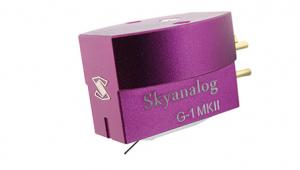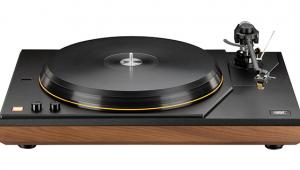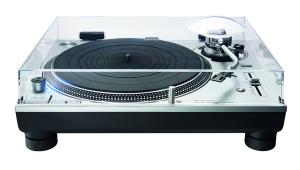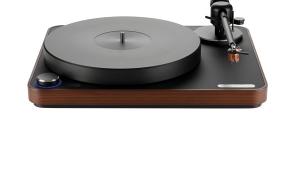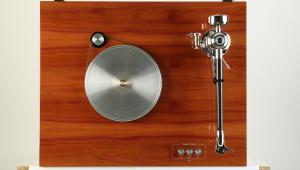Ortofon Mc A90 (£3000)
Heralding Ortofon’s 90th anniversary no less, the MC A90 is the company’s brand new flagship moving-coil cartridge. When we first learned a few months ago about its development and imminent launch, you’d never seen such a scrabble in our editorial office to ensure that
Hi-Fi News secured first dibbs on the first sample to arrive at Henley Designs in Oxfordshire, Ortofon’s UK distributor. It turns out we did better than getting the first in this country. What you’re looking at here is the first sample to leave Ortofon’s Danish factory. How’s that for exclusivity? We’re honoured, naturally.
The MC A90 arrived in a substantial yet not over elaborate presentation box lined internally in suede-covered foam to protect the £3000 jewel held within. Developed to celebrate a significant landmark in Ortofon’s history – how many other audio brands can boast such an illustrious heritage spanning 90 years? – the A90 is as unusual in its appearance as it is cutting-edge in its design.
ART OF SCIENCE
It’s the first time that Ortofon has ever produced an open-bodied pickup with a skeletal design, and to say that it looks different to classic models from Ortofon’s past is like pointing out that a modern, quiet, fully-equipped and fuel-efficient Mondeo bears little resemblance to a 1950s Ford Popular.
Behind the development of this low output MC lays a revolutionary SLM (Selective Laser Melting) manufacturing process in which micro particles are laser-welded together, layer by layer. Frankly, this is almost the stuff of science fiction movies (think Fifth Element).
Ortofon’s promotional literature claims that the SLM manufacturing has enabled the consolidation of components to allow for a design utterly devoid of unnecessary material in order to reduce unwanted body resonance – while maintaining high density and rigidity. All components are built directly into the one-piece body, including the magnetic system (including the moving parts), the terminal block, and the silicone rubber wire guard.
The MC A90 has a boron cantilever together with Ortofon’s top-tier Replicant 100 stylus profile, first used in the company’s MC-3000 MkII and MC-5000 cartridges. It was also used in the MC Windfeld (see boxout).
Apparently the ‘raw component’ resulting from the customised SLM manufacturing requires hand finishing. Consequently, each MC A90 is destined to be unique, with the finish of each structure showing an individual texture.
Mind you, there’s so little of it you’ll probably need a magnifying glass to differentiate between samples. Production is to be limited to just 400 pieces.
DANISH CULTURE
If I’m honest I have to say I was initially a little underwhelmed by the sound of the MC A90. Certainly it sounded gracious, with a clear and open soundstage, but appeared to major on delicacy and refinement rather than ‘body’ and dynamism. Eric Clapton’s ‘Double Trouble’ on the live Just One Night set [RSO, RSDX 2] seemed to lack its familiar raw-edged immediacy and explicit ‘drive’. I considered the A90 a little polite.
Similarly ‘(It’s a) Big World’ from Joe Jackson’s Big World triple-sided vinyl release of 1986 [A&M, JWA3] seemed a little too ‘sat-on’, with less thwack from kick drum and bass than I’m accustomed to. Cymbals shimmered and the A90 dealt with sibilants in its stride, but I prefer to hear more pizzaz, more vigour from a live rock band.
Big World has always been a stern test for a replay system. Recorded live in a theatre but with a silent audience, it’s a direct to two-track digital recording that can sound over-damped with a less-than-vibrant system. Consequently my initial listening notes say, ‘Look elsewhere if you want instruments to jump out and grab your attention’.
THE LONGER RIDE
But the longer I listened the more I appreciated the A90’s tranquil demeanour. Previously I had been using Ortofon’s ruby-cantilevered Kontrapunkt b. Other than substituting the cartridge, nothing in my system had changed, the phono amplifier being Audia’s highly transparent Flight Phono [see HFN August ’09]. The £1000 Kontrapunkt b is perfectly suited to my system, combining refinement with just the requisite bass ‘slam’ I desire and a smooth, silky treble that is forgiving of bright, splashy recordings when combined with a phono stage as sophisticated as the Audia.
The A90 has a cooler balance and is less forgiving. It’s a little less romantic and not a ‘lush’, so it can be struck off any potential shopping list if one’s system already lacks bass weight and energy.
What it certainly doesn’t do is make dull sounding LPs sparkle, or gloss over coarse sounding recordings with a smooth, silky sheen. Fundamentally it sounds honest and matter-of-fact. So I could imagine it sounding sublime on an SME turntable, combined with sweetly balanced electronics, driving electrostatic speakers for example. And given its very high price it perhaps goes without saying that this is not a cartridge to use for playing tired old LPs. The Kontrapunkt b was far kinder and tolerant of my rather noisy, worn out Moving Waves LP by Focus, purchased in 1970 when I was barely out of short trousers.
Later I found myself exploring some audiophile ‘reference’ recordings, such as the Los Angeles Philharmonic’s recording under Zubin Mehta of Edgar Varese’s ‘Arcana’ and ‘Ionisation’ [Decca SXL 6550]. This explosively dynamic, orchestral performance quivered and pulsated with percussive activity. And while the sound was less energetic than with the Kontrapunkt, the three-dimensionality and ‘hear-through’ character of the A90 – lack of character, perhaps I should say – proved little short of revelatory.
Similarly the brightly-lit and thunderous Arnold Overtures on the Reference Recordings label [RR-48] transported body and soul to Watford Town Hall with the orchestra laid before me in holographic fashion. There was air and atmosphere in abundance. While I may have desired more audio fireworks, the A90 simply sounded ‘correct’.
So while the MC A90 might not deliver rock music with gusto and verve compared with many alternatives, its even-handed sonic virtues are clearly evident with well-engineered, audiophile recordings. With the MC A90 it’s a case of ‘less is more’
VERDICT
Not the most exciting transducer ever to grace my record player, the MC A90 is a class act nonetheless. If the high cost of ownership is not an issue and you value neutrality and natural timbre alongside a laidback, almost genteel presentation, you’ll revel in its lack of artificial colour and cultured understatement. You will also be a custodian of a highly exotic and rare exemplar of the pickup makers’ art, that’s for sure.
Originally published in the September 2009 issue







